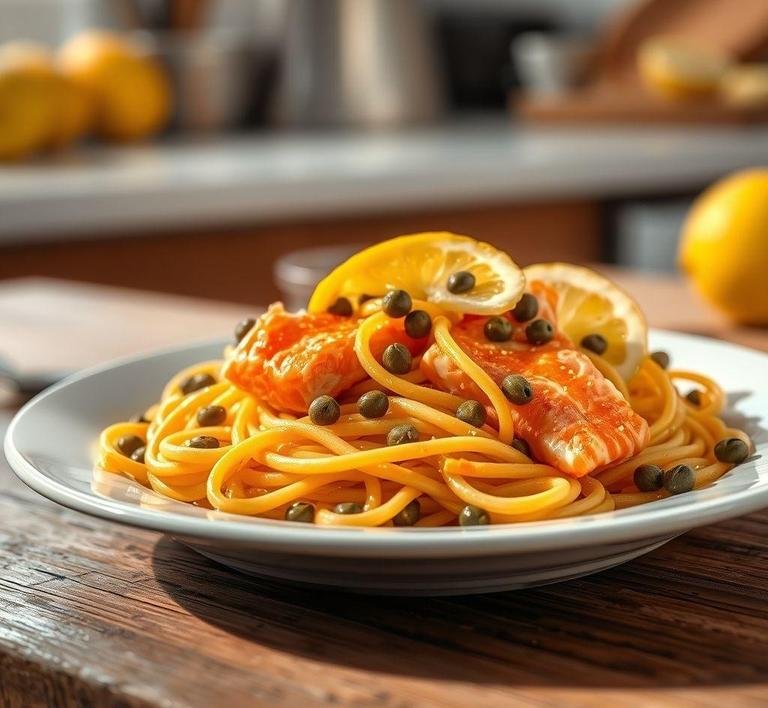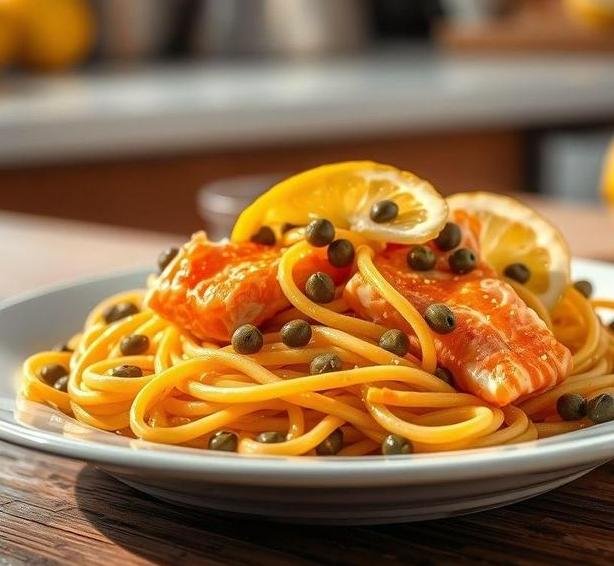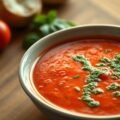Mary Berry’s Lemon and Caper Salmon Linguine is a vibrant and refreshing dish that expertly combines the richness of salmon with the bright tang of lemon and the briny depth of capers. This recipe, beloved by home cooks and professional chefs alike, is a perfect blend of light, fresh flavors and comforting textures. The linguine pasta provides a delicate base that complements the flaky salmon, while the tangy lemon zest and capers add a pop of flavor that enhances every bite. Mary Berry, a British culinary icon, is known for creating dishes that are not only delicious but also accessible to home cooks, and this particular recipe is no exception. It’s a quick, easy-to-follow meal that results in a sophisticated dinner ideal for family gatherings, weeknight meals, or even special occasions. The combination of ingredients creates a harmonious balance of acidity, savory notes, and richness, making this dish a crowd-pleaser and a standout recipe from her vast repertoire.
Mary Berry’s Lemon And Caper Salmon Linguine Recipe
Ingredients Needed

To make Mary Berry’s Lemon and Caper Salmon Linguine, you’ll need a range of fresh and flavorful ingredients. Here’s what you’ll need to gather:
Main Ingredients
- Salmon fillets – Typically, fresh, skinless salmon fillets are used for this recipe. The salmon is flaky and tender, providing a rich, meaty texture to the dish.
- Linguine – This flat, wide pasta is a perfect match for the delicate fish, absorbing the flavors of the sauce while still maintaining a firm bite.
- Lemon – Both the zest and juice of a fresh lemon are essential to infuse the dish with citrusy brightness. The zest gives a burst of fresh fragrance, while the juice adds a sharp tang.
- Capers – These tiny, briny gems are a key component of the dish. They add a unique salty flavor that contrasts beautifully with the rich salmon and the acidity of the lemon.
- Garlic – Fresh garlic is sautéed in olive oil, bringing an aromatic base that enhances the other flavors without overwhelming them.
- Olive oil – Used for sautéing the garlic and for creating a light sauce that helps marry the pasta, salmon, and capers together.
- Fresh parsley – Chopped fresh parsley is used to garnish the dish, adding a pop of color and freshness to the final plate.
- Salt and pepper – These are basic seasoning staples that are added to taste, allowing the natural flavors of the fish and pasta to shine.
Optional Additions
- Cream – Some variations of this dish may call for a splash of cream, creating a richer, silkier sauce to coat the pasta. This is an optional addition depending on personal preference.
- White wine – A splash of dry white wine can be added to the sauce for a more nuanced depth of flavor, though it’s not necessary for the dish to come together.
Equipment Needed
Making Mary Berry’s Lemon and Caper Salmon Linguine is straightforward and doesn’t require any specialized equipment, just the basics that most kitchens will have on hand. Here’s what you’ll need:
- Large pot – This is for cooking the linguine. The pot should be large enough to allow the pasta to cook evenly and to hold enough water for it to move freely.
- Frying pan or skillet – You’ll use this to cook the salmon and sauté the garlic. A large, non-stick frying pan or skillet works best, as it allows for easy flipping of the salmon and prevents sticking.
- Ladle or tongs – A ladle can be used to scoop the pasta out of the boiling water, or alternatively, tongs can be used to transfer the cooked pasta directly into the skillet to combine with the sauce.
- Zester or grater – For zesting the lemon, a zester or fine grater is essential for extracting the lemon rind without the bitter white pith.
- Knife and chopping board – For chopping the parsley and garlic. A sharp knife is key for getting clean, even cuts.
- Measuring spoons – For measuring the salt, pepper, and any optional ingredients such as lemon juice and capers.
Having these essential tools will ensure the dish comes together smoothly.
Instructions To Make Mary Berry’s Lemon And Caper Salmon Linguine
Making this Lemon and Caper Salmon Linguine is a breeze, especially when following Mary Berry’s clear and concise instructions. Here’s a step-by-step guide to creating this flavorful dish:
1. Prepare The Linguine
Start by bringing a large pot of salted water to a boil. Add the linguine and cook according to the package instructions, usually about 8-10 minutes, until it’s al dente. Once cooked, reserve a cup of pasta water, then drain the pasta and set it aside.
2. Cook The Salmon
While the pasta is cooking, heat a large frying pan over medium-high heat and add a little olive oil. Season the salmon fillets with salt and pepper. When the oil is hot, add the salmon fillets to the pan and cook for 3-4 minutes on each side, or until the salmon is golden brown on the outside and just cooked through. Remove the salmon from the pan and set aside to rest.
3. Sauté The Garlic And Prepare The Sauce
In the same pan, reduce the heat to medium. Add a bit more olive oil if necessary and sauté the garlic for 1-2 minutes, until it becomes fragrant but not browned. Add the capers, and cook for another minute, allowing them to release their briny flavor into the oil. Squeeze in the juice of one lemon, then stir everything together. If the sauce feels too thick, you can add a splash of pasta water to thin it out.
4. Flake The Salmon And Combine With The Pasta
While the sauce is cooking, flake the salmon into bite-sized pieces, discarding any bones if present. Add the cooked linguine to the pan, tossing the pasta in the sauce to ensure it’s evenly coated. Add the flaked salmon and toss gently to combine, taking care not to break up the salmon too much.
5. Final Touches
Grate some lemon zest over the dish for an added burst of citrus. Sprinkle with freshly chopped parsley to add a touch of color and a fresh, herby contrast to the dish. Taste and adjust the seasoning with salt and pepper if necessary.
6. Serve
Serve the linguine immediately, ensuring each portion gets a good mix of pasta, salmon, capers, and sauce. Garnish with extra parsley if desired, and a wedge of lemon on the side for an extra zing.
Tips And Tricks
- Salmon Alternatives: If you’re not a fan of salmon, or if it’s unavailable, you can substitute it with other fish such as trout or even grilled chicken breast for a lighter, protein-packed version of the dish.
- Pasta Cooking Tip: Always cook your pasta al dente to avoid it becoming too soft when you mix it with the sauce. The pasta will continue to cook in the pan, absorbing the flavors of the sauce.
- Perfect Sauce Consistency: If the sauce becomes too thick, simply add a little of the reserved pasta water to loosen it up. This will help the sauce cling better to the pasta and provide a creamier texture.
- Caper Substitute: If you don’t have capers, you can try using green olives as an alternative. They won’t provide exactly the same briny flavor, but they will add a nice salty kick to the dish.
- For a Creamier Version: If you like a creamier sauce, add a tablespoon or two of double cream (heavy cream) to the sauce before mixing in the pasta. This will create a richer, more luxurious finish.
- Make it Ahead: This dish is best served fresh, but you can prepare the salmon and pasta components ahead of time. Just reheat everything gently, adding a bit of extra olive oil or pasta water to ensure it doesn’t dry out.
Mary Berry’s Lemon and Caper Salmon Linguine is an irresistible dish that perfectly balances flavors and textures in every bite. The bright and tangy notes from the lemon and capers contrast wonderfully with the richness of the salmon, while the linguine serves as the perfect vessel to bring everything together. This recipe is a fantastic choice for both beginners and experienced cooks due to its simplicity and the elegance it brings to the table. Whether you’re cooking for a special dinner or simply want to treat yourself to a flavorful meal, this dish won’t disappoint. With its ease, versatility, and sheer deliciousness, it’s no wonder this recipe has become a staple in many households. Try it out, and you’ll understand why Mary Berry’s take on salmon linguine is a crowd favorite!
Easy Recipe Variations For Mary Berry’s Lemon And Caper Salmon Linguine

Mary Berry’s Lemon and Caper Salmon Linguine is already a wonderfully simple yet elegant dish, but it can easily be adapted to suit different tastes, dietary preferences, or what you have on hand in your kitchen. Here are some delightful variations that can elevate the dish or add a unique twist:
1. Swap The Salmon For Another Fish Or Protein
While salmon is the star of the dish with its rich, buttery flavor, you can experiment with other proteins to change the character of the dish. For instance:
- Tuna: Fresh, grilled tuna steaks can replace salmon for a more meaty, dense texture. Canned tuna (preferably in olive oil) also works well for a quicker, budget-friendly alternative.
- Shrimp: Light and succulent, shrimp adds a sweetness to the dish. Sauté shrimp in garlic and butter before tossing it with the linguine and lemon-caper sauce.
- Chicken: For those who prefer chicken, use grilled chicken breast or thigh fillets, chopped into bite-sized pieces, for a leaner alternative.
- Vegetarian Option: For a meat-free alternative, roasted vegetables like zucchini, bell peppers, and cherry tomatoes can be tossed through the pasta, paired with the same lemon-caper sauce.
2. Noodles And Pasta Alternatives
Linguine pairs wonderfully with this dish, but if you’re looking for a change, consider these pasta alternatives:
- Spaghetti: This classic pasta variety is an easy substitute and works just as well.
- Fettuccine: The broader, flat noodles of fettuccine provide a slightly more substantial base for the creamy sauce.
- Whole Wheat or Gluten-Free Pasta: If you’re watching your carbs or need gluten-free options, whole wheat or gluten-free pasta can add a nutty flavor and heartier texture to the dish.
- Zucchini Noodles (Zoodles): For a lower-carb version, spiralized zucchini noodles provide a fresh, crunchy texture, perfect for summer months.
3. Adding Extra Flavors
The combination of lemon and capers is fresh and tangy, but you can enhance this profile with a few extra ingredients:
- Fresh Herbs: Basil, parsley, or dill can add a fresh, fragrant note. Fresh thyme can also complement the lemony flavors beautifully.
- Garlic: For garlic lovers, sauté some crushed garlic in olive oil before adding the salmon for an extra punch of flavor.
- Chili Flakes: A pinch of chili flakes can add a spicy kick to the dish, balancing the richness of the salmon and the acidity of the lemon.
- Creamy Touch: If you prefer a richer sauce, add a touch of heavy cream or crème fraîche for a velvety texture, giving the dish a luxurious feel.
4. Vegetable Additions
Incorporating vegetables into your linguine can add color, crunch, and extra nutrients:
- Spinach: A handful of fresh spinach wilted into the pasta gives the dish a vibrant green color and a mild, earthy flavor that complements the salmon.
- Asparagus: Lightly steamed asparagus adds a crisp texture and works beautifully with the citrus and caper notes.
- Peas: Sweet peas, either fresh or frozen, are a great addition for a burst of sweetness and color.
5. Caper-Free Version
If you’re not a fan of capers, you can swap them out for something else with a briny, tangy character. Green olives or pickled gherkins can add a similar zing to the dish without the distinct taste of capers. Alternatively, a bit of lemon zest could amp up the citrus notes in place of the capers.
Storing Leftovers
Leftover Lemon and Caper Salmon Linguine can be a great meal for the next day, but it’s important to store it properly to maintain the flavor and texture of the dish.
1. Storage
- Refrigeration: Place any leftover salmon linguine in an airtight container and refrigerate. It should be eaten within 1-2 days to ensure the freshness of the fish and pasta. Salmon, being a delicate protein, tends to lose its optimal flavor after being stored for too long.
- Freezing: While pasta dishes can often be frozen, it’s not ideal to freeze this dish because the salmon may lose its texture when reheated. If you must freeze it, try to separate the pasta and salmon, then freeze them in individual portions. You can also freeze just the pasta in its sauce if you’re planning to add fresh salmon later on.
2. Reheating Tips
- Microwave: If you’re reheating leftovers in the microwave, cover the dish loosely with a microwave-safe lid or wrap to trap moisture. Heat in short intervals (1-2 minutes), stirring in between to ensure even heating. Adding a splash of water or extra olive oil can help restore some of the moisture lost during storage.
- Stovetop: For better texture, reheat the linguine in a skillet over medium heat. Add a touch of olive oil or a knob of butter, along with a splash of water or white wine, and stir frequently to bring it back to life. This method helps preserve the sauce’s consistency and the salmon’s texture.
What To Eat With Mary Berry’s Lemon And Caper Salmon Linguine?
To make this dish even more delightful, pair it with side dishes and beverages that complement its bright, tangy flavors. Here are some ideas for sides and drinks to serve alongside your linguine:
1. Side Dishes
- Garlic Bread: A classic pairing, the warm, crispy bread complements the creamy pasta and soaks up any remaining lemon-caper sauce. For extra flair, top the garlic bread with a sprinkle of fresh parsley or grated parmesan.
- Mixed Green Salad: A light, refreshing salad can balance the richness of the linguine. Toss together some mixed greens, such as arugula, baby spinach, and rocket, with a simple lemon vinaigrette to echo the citrus flavors in the main dish.
- Roasted Vegetables: Roasted carrots, asparagus, or Brussels sprouts would pair wonderfully, offering a savory contrast to the pasta’s brightness. The caramelized edges of roasted vegetables add depth to the dish.
- Steamed Broccoli: If you’re looking for a healthy, vibrant side, steamed broccoli adds a nice crunch and pairs perfectly with the richness of the salmon.
2. Drinks
- White Wine: A crisp, dry white wine, such as a Sauvignon Blanc or Pinot Grigio, is an excellent match for this dish. The acidity and freshness of the wine will enhance the tanginess of the lemon while balancing the richness of the salmon.
- Sparkling Water: For a non-alcoholic option, sparkling water with a twist of lemon or lime can refresh the palate between bites. The bubbles help cleanse the mouth and provide a light, refreshing contrast to the creamy pasta.
- Iced Tea: A lightly brewed iced tea with a touch of lemon and mint can bring a refreshing, herbal element to the meal, making it ideal for warm weather or casual dining.
Conclusion
Mary Berry’s Lemon and Caper Salmon Linguine is a delightful dish that balances fresh, vibrant flavors with the richness of salmon and the zing of capers. Whether you’re looking for a light weeknight meal or something special for a dinner party, this recipe’s versatility makes it a winner in any kitchen. From swapping proteins to experimenting with pasta types and adding fresh vegetables, there’s a wide range of ways to put your spin on this recipe.
The addition of side dishes, like a simple salad or crusty garlic bread, and thoughtful drink pairings ensure that this meal can be a complete culinary experience. And with proper storage and reheating tips, you can enjoy this dish again the next day without compromising on quality. So next time you’re craving a meal that’s quick, delicious, and full of flavor, Mary Berry’s Lemon and Caper Salmon Linguine is a perfect choice.
FAQs
What Ingredients Are Needed For Mary Berry’s Lemon And Caper Salmon Linguine?
The key ingredients for Mary Berry’s lemon and caper salmon linguine include fresh salmon fillets, linguine pasta, capers, a lemon (for both zest and juice), garlic, olive oil, butter, and a handful of fresh parsley. Some recipes may also include a dash of white wine or cream to add richness to the sauce.
Can I Substitute The Salmon In Mary Berry’s Lemon And Caper Salmon Linguine With Another Type Of Fish?
Yes, you can substitute salmon with other fish like trout, sea bass, or even cod, depending on your preference. Just ensure the fish is cooked to flake easily, and adjust the cooking time to suit the fish you choose. While salmon provides a rich flavor, other fish varieties will work just as well in the recipe.
How Do I Ensure The Sauce In Mary Berry’s Lemon And Caper Salmon Linguine Is Creamy And Not Too Dry?
To make sure the sauce in Mary Berry’s lemon and caper salmon linguine is creamy, be sure to use enough olive oil and butter when making the base of the sauce. If the sauce seems too dry, you can add a splash of pasta cooking water or a little cream. Stirring the linguine into the sauce immediately after draining helps the pasta absorb the sauce’s flavors, creating a smooth, rich texture.


